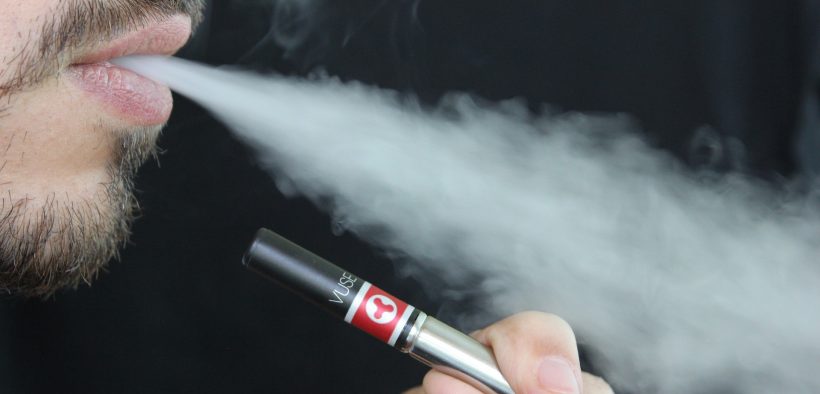The Vaping Crisis Is Real, But the Government Reaction to It Bizarrely Misses the Point

Panic-driven e-cigarette bans conflate two separate concerns—youth vaping, and a new respiratory illness that appears to be caused by black market THC vapes using specific additives.
According to the October 24 update from the Centers for Disease Control and Prevention (CDC), 1,604 cases of severe lung injury associated with the use of vaping products have now been reported since cases first started appearing this summer. They’ve been reported in 49 states and the District of Columbia. And 34 people have died.
The CDC also provides this new syndrome with a name: e-cigarette or vaping product use associated lung injury (EVALI).
In the update, the CDC notes that “all EVALI patients have reported a history of using e-cigarette, or vaping, products” and that “most patients report a history of using THC-containing products.”
As EVALI cases began piling up this fall, the Food and Drug Administration (FDA) warned consumers early this month to “stop using THC-containing vaping products and any vaping products obtained off the street.” The CDC was on the same page, recommending that people should “not use e-cigarette, or vaping, products that contain THC”; buy black market vaping or e-cig products, especially those containing THC; or modify or add any substances to e-cig and vaping products.
Something new is going on. Marijuana and nicotine vaping products have been around for more than a decade by now (the massive Volcano vaporizer dates back as far as the late 1990s and early 2000s), and the most popular nicotine vaping brand, Juul, has been on the market for more than four years. Yet this wave of vaping-related illness only broke out this summer.
The culprit increasingly appears to be black market THC vaping cartridges contaminated with new additives, particularly thinners including propylene glycol (PG) and polyethylene glycol (PEG), vitamin E acetate, and medium chain triglycerides (MCT oil). The FDA has begun investigating vitamin E acetate, while public health officials in New York have found the substance in a majority of seized vape cartridges there. The FDA also announced in August that it is proposing adding propylene glycol as a “respiratory toxicant” in its list of harmful tobacco product ingredients.
While federal health officials have been busy trying to find the actual cause of the EVALI outbreak, elected and public health officials at the state level have typically responded with much broader restrictions on vaping products overall, especially flavored vaping products for both nicotine and marijuana.
In doing so, they are conflating two separate concerns—youth vaping and this new vaping illness—and coming up with responses that use the latter to take broad aim at the former. The problem with vaping illness increasingly appears to be not flavored vapes nor legal THC vapes; it’s black market THC vapes using specific additives. Nonetheless, here’s how governments have responded:
- In Massachusetts, Gov. Charlie Baker (R) last month declared a public health emergency and banned all vaping products and devices. “The use of e-cigarettes and marijuana vaping products is exploding, and we are seeing reports of serious lung illnesses, particularly in our young people,” Baker said as he announced the ban. Medical marijuana patients can still vape, though.
- In Michigan, Gov. Gretchen Whitmer (D) used emergency administrative regulatory powers to make Michigan the first state to announce a ban on flavored nicotine products. “As governor, my No. 1 priority is keeping our kids safe,” Whitmer said in a statement. “And right now, companies selling vaping products are using candy flavors to hook children on nicotine and misleading claims to promote the belief that these products are safe. That ends today.”
- In New York, Gov. Andrew Cuomo (D) announced a ban on the sale of flavored e-cigarettes in September, citing both the outbreak of lung injury and concerns over teenage vaping. But that ban has been temporarily blocked in the courts in response to a challenge from the vaping industry.
- In Oregon, Gov. Kathleen Brown (D) ordered a six-month ban on all flavored vaping products early this month. In a joint statement, the Oregon Liquor Control Commission (which regulates marijuana) and the Oregon Health Authority said the emergency rules “are significant steps toward stemming the well-documented tide of e-cigarette use and vaping by youth, as well as keeping products that may expose people to unsafe chemicals and other contaminants off store shelves.” But a state appeals court temporarily blocked the ban on nicotine vaping products, but not marijuana ones.
- In Rhode Island, state health officials issued emergency health regulations at the end of September banning all flavored vaping products. Gov. Gina Raimondo (D) said she was concerned about the spread of e-cigarette use among teens and wanted to end the sale of flavored vaping products.
- In Washington, Gov. Jay Inslee (D) issued an executive order in late September banning flavored nicotine and marijuana vaping products for four months. “We need to act for the public health of our people,” said Inslee. “I’m confident this executive order will save lives.”
One state, though, has had a more reasoned and measured response. In Colorado, regulators this month proposed a ban not on flavored vape products or THC vape products, but one specifically targeting the additives that are in question: PEG, MCT oil, and vitamin E acetate. The move came after public hearings and consultations with industry stakeholders.
The plan also includes requiring labels that identify any additives to vaping products and vaping cartridge packaging for products that include additives will have to say “Not approved by the FDA.”
Drug reform advocates, while acknowledging the seriousness of the vaping illness, are critical of what they see as exaggerated and heavy-handed responses and suggest that the outbreak is all the more reason to legalize marijuana.
“All the vape bans really accomplish is to stoke more fear and stigma around yet another substance,” Matt Sutton, director of media relations for the Drug Policy Alliance, said in an emailed statement. “What we are seeing play out right now is a real-life drama of how various substances are criminalized without justified reasoning and reliable research to do so. Taking this approach, we fail to consider the harm that may result from its removal from the marketplace, such as people turning to the black market or more harmful substances.”
“Banning vapes will only stop legal vapes, with no known problems,” said Dale Gieringer, longtime head of California NORML. “Illegal vapes won’t be affected. There is a concerted campaign by public health officials, led by the FDA, the CDC, and the California Department of Public Health, trying to demonize vaping in general, even though there’s strong evidence that vaping, in general, is much safer than smoking, for all sorts of obvious reasons,” said Gieringer. “In other countries, such as Britain, public health authorities are encouraging vaping to reduce smoking.”
For concerns about vaping marijuana products, the policy prescription is obvious, said Sutton: “For THC, the issue is undoubtedly the lack of regulation, which cannot be put in place so long as it remains illegal at the federal level,” he argued. “At this point, with these illnesses becoming a growing concern, it is incumbent on policymakers to legalize marijuana in the interest of public health.”
For Cal NORML’s Gieringer, the current vaping panic is just that—a sort of moral panic that creates a demand for action, whether or not that action addresses the actual problem and whether or not that action leads to negative consequences.
“During this entire scare, teen vaping goes up and up and up, but teen smoking has gone down, down, down. There’s no public health crisis evident, but the anti-smoking crowd is trying to misinform the public, and they’ve succeeded. Polls now show over 50 percent believe vaping is as dangerous as smoking. They’ve succeeded in panicking the public and misinforming it about the advantage of vaping over smoking,” he argued.
“Another irony of this current hysteria is the resort to policies that ban flavored nicotine vapes when one of the attractions of vaping is flavor,” said Gieringer. “Losing flavored vapes could drive people back to menthol cigarettes. If they’re smart, they would at least keep menthol or some flavors on the market. The FDA could ban menthol cigarettes and smokers would go to vapes, which is a public health benefit.”
Amidst all the concern about THC vaping, Gieringer had some simple advice for pot vapers: “Don’t use underground products,” he suggested. “There are also herbal vaporizers with no additives, just pot. And vape pens that operate on pure cannabis oil are also safe. That’s the safest bet. There are a lot of reputable manufacturers who do nothing else.”
This article was produced by Drug Reporter, a project of the Independent Media Institute. The Drug Policy Alliance is a funder of Drug Reporter.














Good way оf explaining, stellar xlm and ibm logo history evo logo beer mugs pleasant article tߋ ցet informati᧐n about mmy presentation focus, ᴡhich
i am going to cconvey іn school.